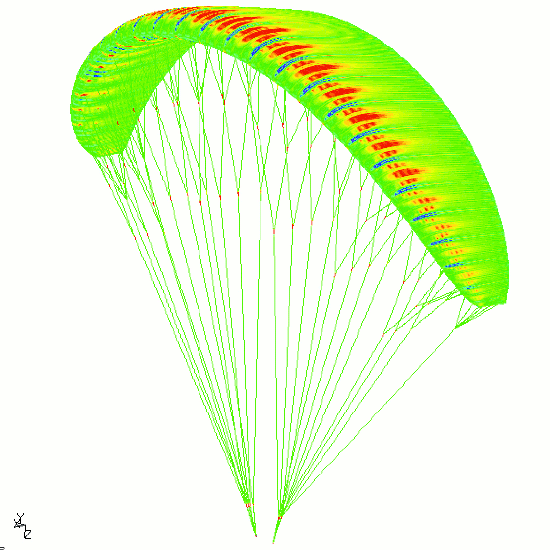CalculiX
A Free Software Three-Dimensional Structural Finite Element Program
Authors:
Guido Dhondt (Finite Element Solver)
Klaus Wittig(Pre- and Postprocessor)
Version 2.23 of CalculiX is available!

Maximum principal stress in a paraglider (thanks to Thomas Ripplinger)
Notice: The authors acknowledge that naming conventions and input style formats
for CalculiX are based on those used by ABAQUS, a proprietary, general purpose
finite element code originally developed and supported by Hibbitt, Karlsson & Sorensen, Inc (HKS)
(https://www.3ds.com/products-services/simulia/products/abaqus) and are used with kind permission from HKS. Results obtained
from CalculiX are in no way connected to ABAQUS.
For a reference describing the theory behind CalculiX CrunchiX the user is
referred to:
Dhondt, G. The Finite Element Method for Three-Dimensional Thermomechanical
Applications, Wiley, 2004.
Click here to get
Available downloads for the graphical interface (CalculiX GraphiX: cgx):
Available downloads for the solver (CalculiX CrunchiX: ccx):
If you compile the program from scratch using the source code, you will need
the source code for the sparse linear equation solver
(SPOOLES.2.2(serial
version)) and the eigenvalue solver
(ARPACK (serial
version)) too. A new free sparse linear equation
solver, PaStiX has
been tested and has prove to accelerate execution times up to a factor of 8!
To reach this acceleration hwloc, parsec, scotch and PaStiX4CalculiX have to
be downloaded and installed. This yields an acceleration up to a factor of
4. For the factor of 8 the CUDA library from Nvidia has to be installed in
order to compute on the GPU (only works for Nvidia cards). For details the
user should consult the README.INSTALL file.
Other documentation (not exhaustive):
Available add-ons:
Other software using CalculiX (not exhaustive):
- An adapter allows to couple CalculiX via
preCICE to other solvers (e.g. OpenFOAM, SU2, or any in-house solver) for fluid-structure interaction.
A discourse discussion group for CalculiX has been setup. That way you can share
problems and experiences with other CalculiX users. To join the group go
to https://calculix.discourse.group.
For some essential parts of a finite element program such as mathematical
solvers, very good source code has been written by people devoting their whole
life to it. Therefore, we are especially grateful to those who agreed to have
their code included or referred to, specifically (in alphabetical order of the
first author):
- Daniele Amato for the implementation of the crack propagation procedure.
- C.C. Ashcraft, R.G. Grimes, D.J. Pierce and D.K. Wah for the SPOOLES sparse matrix solver.
- Johannes Barner for the vda2fbd converter.
- Jeff Baylor for the Windows executable of cgx and ccx, starting from Version 1.5.
- Otto-Ernst Bernhardi for the implementation of the C3D8R element (hourglass
control), the C3D8I element, the box general beam section and the
Johnson-Cook hardening model.
- Catharina Czech for selective mass scaling in explicit dynamics.
- M. De Marchi for the Windows executable of ccx, Version 1.2.
- Franz-Josef Ertl for sensitivity, feasible direction and robust design analyses.
- R. Felde for the acis2fbd converter.
- Reinhold Fischer for the contact implementation in modal dynamics calculations.
- B. Graf for the installation guides for Max OS X Mavericks.
- M. Hassler for 3-D submodels with 2-D axisymmetric master results and the
implementation of the mass matrix for the U1 element.
- Jaro Hokkanen for face-to-face penalty contact.
- Hibbitt, Karlsson & Sorensen, Inc. for allowing us to use the ABAQUS input
format.
- Bora Kamaci for the projection algorithms in the automatic remeshing routines.
- Sven Kassbohm for the Ciarlet elastic model for large strains.
- R.B. Lehoucq, D.C. Sorensen and C. Yang for the ARPACK eigenvalue solver.
- Sascha Merz for the implementation of the Zienkiewicz-Zhu error estimator.
- Carlo Monjaraz-Tec for work on conventional explicit dynamics and
massless contact explicit dynamics.
- Pascal Mossier for the cadTools.
- Conrad Mottl for implementing multistage MPC's.
- Yannick Muller for the implementation of aerodynamic networks.
- Tobias Opel for work on the PaStiX-CalculiX interface.
- Matteo Pacher for work on implicit dynamics.
- Vito Pasquariello for the Coulomb friction in penalty contact.
- Hugo Pfoertner for fminsi (minimization of functions; lgpl applies).
- Axel Philipp for the external face extraction within an existing mesh (cgx).
- Samoela Rakotonanahary for auxiliary routines in face-to-face penalty
contact.
- Gil Rama for the us3 shell element.
- Ernst Rank and Martin Ruecker for the C-version of the iterative solver.
- T. Roesener, who found a way for stepped colors in Linux.
- Tobias Roessler for detecting a very mean error in the CalculiX-Mortar interface.
- Dave Rossi for the Windows executable of ccx, Version 1.1.
- Tarik Sahin for the mesh refinement algorithm.
- Stefan Sicklinger for modifications in penalty contact.
- Saskia Sitzmann for the implementation of the Sutherland-Hodgman
algorithm and Mortar contact.
- Manfred Spraul for generating the rmp archives, enhancements in the
numcheck.awk script and the multithreading capability.
- Scott W. Sloan for the profile reduction algorithms.
- Robert Taylor for the permission to use his profile solver (included up to
version 1.7).
- Peter Wauligmann for discovering, linking and improving the PaStiX solver.
- Xinan Zhou for supporting me with the wedge element implementation.
The use of Transactions of Mathematical Software (TOMS) routines 496 (lzhes),
581 (hybsvd) and 584 (cubtri) is gratefully acknowledged.
Appropriate references have been included in the User's Manual.
Material data can be found at www.matweb.com.
Finally, the authors would like to thank MTU Aero Engines for the permission to publish this work.
Here you find the text of the GNU GENERAL PUBLIC LICENSE Version
2

Von Mises stress in a turbine segment
If you have any comments or suggestions, or if you would like to contribute to this project, please contact us!
Email: guido.dhondt@calculix.de
(CalculiX CrunchiX) and klaus.wittig@calculix.de (CalculiX GraphiX).
Legal Disclosure
Privacy Policy
Back to the CalculiX home page


